Properties of the electric and magnetic fields as predicted by Maxwell's equations
Classical physics is our model of the laws that govern the
behavior and interactions of macroscopic objects in the world around us.
All the laws of classical physics were known by the end of the 19th
century. Classical physics works well describing and predicting almost all
everyday phenomena, but it starts to fail when things get too ... .
(You can insert any extremes here, for example big, small,
hot, cold, fast, etc.)
In classical physics the world is made of matter
particles that behave according to Newton's
laws of motion. To use Newton's laws, we need to know which forces are acting
on the particles. The interactions that give rise to the forces between the
particles are represented by fields.
Electric and magnetic fields represent the electromagnetic interactions. If we
know the fields, we know the electric and the magnetic forces acting on charged
particles.
F = Felectric + Fmagnetic
= qE + qv × B = q(E +
v × B).
In classical physics our model for the electromagnetic
fields is a set of four equations, called Maxwell's
equations. They let us predict E and
B. They have a
broader range of applicability than Newton's laws. They are relativistically
correct, and correctly describe the fields when relative speeds approach the
speed of light. But the classical model for the electromagnetic fields no
longer describes observations correctly on the scale of atoms or elementary
particles.
Static fields
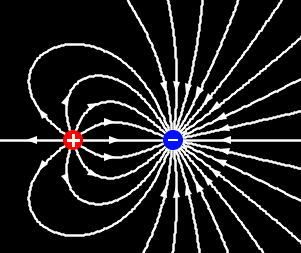 Maxwell's equations predict that static
electric fields,
i.e. field that do not change with time, are produced by charges. Charges are
sources and sinks of field lines. Static electric field lines begin on positive
and end on negative charges.
Maxwell's equations predict that static
electric fields,
i.e. field that do not change with time, are produced by charges. Charges are
sources and sinks of field lines. Static electric field lines begin on positive
and end on negative charges.
Static electric field
lines NEVER form loops.
The static electric field is a
conservative field. If you do work on a charge against the static electric
field, this work is stored as potential energy. The potential energy is a
function of position only. You can let the electric field do work to
recover the energy you expended in moving the charge.
In statics, Maxwell's equations for the electric field
combine to give you Coulomb's law and the principle of superposition.
Everything else is just vector addition.
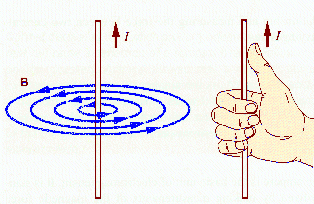 Maxwell's equations predict that static magnetic fields are
produced by steady currents. There are no magnetic charges, and
therefore no sources and sinks for magnetic field lines.
Maxwell's equations predict that static magnetic fields are
produced by steady currents. There are no magnetic charges, and
therefore no sources and sinks for magnetic field lines.
Static magnetic fields lines
ALWAYS form
closed loops.
They encircle moving charges according to the right
hand rule.
Induced fields
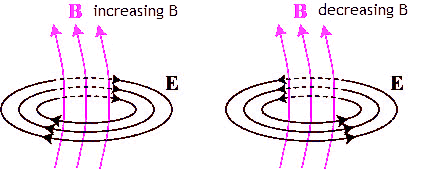 Maxwell's equations also tell us that
there is another source of electric and magnetic fields,
when either of those fields changes with time.
Maxwell's equations also tell us that
there is another source of electric and magnetic fields,
when either of those fields changes with time.
- Changing magnetic fields are a source of electric
fields.
- Changing electric fields are a source of magnetic
fields.
The key word is CHANGE.
The fields produced by this CHANGE are called dynamic or induced fields. The induced fields do not
have sources or sinks.
Field lines of induced, dynamic fields
ALWAYS form closed loops. They always have circulation.
Mathematical definition of circulation of a vector field:
Take any closed loop, for example a circle. At a fixed
time, move in small steps ∆r once around the loop. (You should take
infinitessimally small steps.) At each step calculate the product of the
tangential component of the field time ∆r. For the electric field, for
example, calculate E∙∆r. Sum up all these products as you go once
around the loop.
Example
The circulation of
E around a closed loop = Σaround loop
E∙∆r.
For induced fields, the circulation is always non-zero.
How much circulation is there?
Maxwell's equations tell us about the
magnitude and the direction of the circulation. One of the equations is called
Faraday's law. For the absolute value
or magnitude, Faraday's law states that the circulation of the
electric field E around any closed loop is equal to the
RATE OF CHANGE
of
the magnetic flux through the area enclosed by the loop.
Remember flux:
The flux of a vector field through a surface area is the
amount of whatever the field represents passing through the area. The
total flux depends on strength of the field, the size of the surface area it
passes through, and on how the area is oriented with respect to the field.
You can think of flux as the amount of something crossing a surface.
The surface is a two dimensional (real or imagined) boundary. It can be
open or closed. An open surface could be the area of a door, the area of a
sheet of paper, the area of a bowl, etc. A closed surface could be the
surface area of a sphere or a cube, etc. Flux is measure at a single point
in time. Flux is the total amount of something crossing the surface, it is
not something per unit area, etc.
Field lines help us to visualize the field. The density of the
field lines is proportional to the strength of the field. The number of
field lines passing through a geometrical surface of given area depends on three
factors.
- the strength of the field
- the surface area
- the orientation of the surface
The number of field lines passing through an area A is proportional
to the flux through that area.
We define the electric flux through an ΔA area as ΔΦE =
E∙ΔA = E ΔA cosθ.
The magnetic flux is defined in an
analogous way as ΔΦB = B∙ΔA B ΔA cosθ.
Problem:
Find the magnetic flux through each of the coils below.
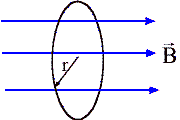 (a) A magnetic field of magnitude B = 5 mT points
along the normal of a circular turn of wire of radius r = 1 cm.
(a) A magnetic field of magnitude B = 5 mT points
along the normal of a circular turn of wire of radius r = 1 cm.
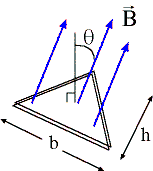 (b)
A magnetic field of magnitude B = 5 mT makes an
angle θ = 20o with the normal of triangular coil of 50 turns
with base b = 5.0 cm and height h = 4 cm.
(b)
A magnetic field of magnitude B = 5 mT makes an
angle θ = 20o with the normal of triangular coil of 50 turns
with base b = 5.0 cm and height h = 4 cm.
Solution:
-
Reasoning:
The magnetic field B is constant over the whole area. The
magnetic flux is ΦB = B A cosθ.
-
Details of the calculation:
(a) ΦB = B A cosθ = B A = (5*10-3 T)(π*10-4
m2) = 1.57*10-6 Tm2.
(b) ΦB
= B A cosθ. Since the coil has 50
turns, A = 50 times the area of the triangle.
ΦB = (5*10-3 T)(50*5*10-2*2*10-2
m2)*cos(20o) = 2.35*10-4 Tm2.
 Problem:
Problem:
A rectangular loop of N turns is rotating about an axis in a region of uniform magnetic field, as shown in the figure on the
right.
Describe how the magnetic flux through the loop is changing with time.
Solution:
- Reasoning:
ΦB = B A cosθ = B N Arectangle cosθ.
The product B N Arectangle is constant, but θ, the angle
B makes with the normal, is changing with time.
(For a flat area you can choose the direction of the normal. Assume a
flat area lies in the xy-plane. The normal to this area is the
z-axis, for its direction you can choose the positive or negative
z-direction.)
If the magnetic field at t = 0 is aligned with
the normal, then the flux has its maximum positive value at t = 0.
It deceases towards zero as θ approaches 90o, reaches its
maximum negative value at θ = 180o, approaches zero again
as θ approaches 270o, and reaches its maximum positive
value again at θ = 360o.
The flux is continuously
changing.
Whenever the magnetic field though any loop changes, and electric field
circulates around the loop.
Faraday's law states that the magnitude of the circulation of the
electric field E around any closed loop is equal to the
magnitude of the RATE OF CHANGE
of
the magnetic flux through the area enclosed by the loop.
Another of Maxwell's equations is the Ampere-Maxwell
law. It
states that the circulation of the magnetic field B
around any closed loop is the sum of two terms. The static term is proportional
to the current flowing through the loop and the dynamic term is proportional to
the RATE OF CHANGE of the electric flux through the area enclosed by the loop.
This interplay between induced electric and magnetic fields leads to the
production of electromagnetic wave.
Electromagnetic
waves are solutions to Maxwell's equations, even in free space, when
no charges or currents are present.
 Maxwell's equations predict that static
electric fields,
i.e. field that do not change with time, are produced by charges. Charges are
sources and sinks of field lines. Static electric field lines begin on positive
and end on negative charges.
Maxwell's equations predict that static
electric fields,
i.e. field that do not change with time, are produced by charges. Charges are
sources and sinks of field lines. Static electric field lines begin on positive
and end on negative charges.  Maxwell's equations predict that static magnetic fields are
produced by steady currents. There are no magnetic charges, and
therefore no sources and sinks for magnetic field lines.
Maxwell's equations predict that static magnetic fields are
produced by steady currents. There are no magnetic charges, and
therefore no sources and sinks for magnetic field lines.  Maxwell's equations also tell us that
there is another source of electric and magnetic fields,
when either of those fields changes with time.
Maxwell's equations also tell us that
there is another source of electric and magnetic fields,
when either of those fields changes with time. (a) A magnetic field of magnitude B = 5 mT points
along the normal of a circular turn of wire of radius r = 1 cm.
(a) A magnetic field of magnitude B = 5 mT points
along the normal of a circular turn of wire of radius r = 1 cm. (b)
A magnetic field of magnitude B = 5 mT makes an
angle θ = 20o with the normal of triangular coil of 50 turns
with base b = 5.0 cm and height h = 4 cm.
(b)
A magnetic field of magnitude B = 5 mT makes an
angle θ = 20o with the normal of triangular coil of 50 turns
with base b = 5.0 cm and height h = 4 cm. Problem:
Problem: